Ever feel like your Google rankings are playing a game of musical chairs?
You check your position in the morning, top five. By lunch? You’ve vanished like your willpower on a Monday.
Welcome to SERP volatility.
It’s the glamorous term for why your keyword rankings seem to wobble every time you blink. Sometimes it’s a small shift. Other times it’s a full-on rankings rollercoaster. And yes, it’s perfectly normal. Mostly.
But if your site’s doing the SEO equivalent of free-falling from a cliff, something bigger might be happening.
Think algorithm updates, AI search changes, or even technical gremlins hiding in your site.
In this guide, I'm breaking down what causes SERP chaos, how to monitor it, and how to stop panicking every time your rankings dip a little.
What you will learn
- What SERP volatility really is (and how to tell if your site is affected)
- Common causes of sudden or frequent ranking fluctuations
- How to monitor and respond to volatility using Surfer’s SEO tools and Google Search Console
What is SERP volatility?
SERP volatility refers to how often and how drastically search engine rankings change over time.
It’s the digital equivalent of weather; sometimes calm, sometimes full-blown hurricane.
Ranking shifts can happen daily, even hourly. One moment your page is riding high in position two, the next it’s dropped five places without warning. These fluctuations can impact just a handful of keyword rankings or shake up an entire niche.
Some movement is completely normal. Google’s constantly updating its index, testing new SERP features, and learning from user behavior.
But when changes are extreme or sustained, it could be a sign of something bigger, like an algorithm update or an issue with your site.
Here’s a visual example from one of our blog posts.
Notice the difference between stable performance and a page caught in a volatile swing. This is exactly the kind of pattern I'm talking about:

How to identify SERP volatility
Spotting SERP volatility starts with one thing: watching your keyword rankings like a hawk.
If you're not keeping tabs, you won’t notice the shake-ups until it's too late.
The easiest way to monitor volatility is by tracking your rankings over time.
Look at daily or weekly position changes across your most important target keywords.
If you’re seeing big jumps or sudden drops—especially across multiple search queries—you may be dealing with a volatile SERP.
A little fluctuation is expected. Google’s always crawling, testing, and re-evaluating. But when you see sharp dips across the entire site, it’s time to dig deeper.
Major swings often mean an external force is at play, like algorithm updates, technical issues, or changes in how users are searching.
You can spot volatility manually with regular SERP checks. But most SEO professionals rely on tracking tools for the heavy lifting.
Two solid options?
Surfer’s Rank Tracker and volatility indexes like Semrush Sensor. I’ll break those down later.
7 most common causes of ranking fluctuations
Sometimes rankings drop because Google’s shaking things up. Other times, it’s your competitors, your content, or your site itself.
Before you panic, here are the most common reasons why your search engine rankings might be jumping around like they had too much caffeine.
1. Algorithm updates
Google’s search algorithm is what decides which pages show up in search results and in what order. It’s like the invisible judge behind every Google query, evaluating millions of pages in real time.
But here’s the catch: that judge is constantly changing the rules.
Google makes updates to its algorithm regularly. Sometimes multiple times a day.
These updates are designed to improve the quality of search results, helping users find the most accurate, helpful, and trustworthy information.
Some Google algorithm updates are small and barely noticeable. Others can shake up the entire search engine rankings landscape. When your keyword rankings suddenly drop or jump, there’s a good chance an update is behind it.
Google doesn’t always announce these changes, but when it does, it usually means the update is big.
These larger updates are often aimed at things like content quality, user experience, or cracking down on tactics like keyword stuffing or link manipulation.
Some updates target broad parts of the web.
Others focus on specific categories, like Your Money or Your Life (YMYL) sites, which cover health, finance, and other sensitive topics. These sites are held to higher standards because misinformation could seriously harm users.
To keep track of what’s happening, check the Google Search Status Dashboard. It lists confirmed algorithm updates and is a great first stop when you notice rankings shifting across your site.

A prime example of the impact updates can have is the 2023 Helpful Content Update (HCU).
This update was meant to reward content written for people, not search engines. But many publishers saw massive ranking drops, even with original, high-quality content.
One of the most well-known cases was HouseFresh, a site that lost visibility almost overnight despite doing all the right things.
So if your rankings suddenly change, don't panic right away.
First, check if Google recently rolled out an update. Sometimes the problem isn't your SEO strategy—it's the algorithm shifting the goalposts.
2. Emerging AI searches
Remember when ranking at the top of Google meant you actually got the clicks?
Those days are getting… complicated.
Google has been rolling out AI-generated results like AI Overviews and AI Mode, which sit right at the top of the SERP. They don’t just share space with organic results.
They push them down, swap them out, or hide them behind collapsible elements like People Also Ask and Knowledge Panels. In some cases, your link doesn’t even show unless a user scrolls and clicks to expand.
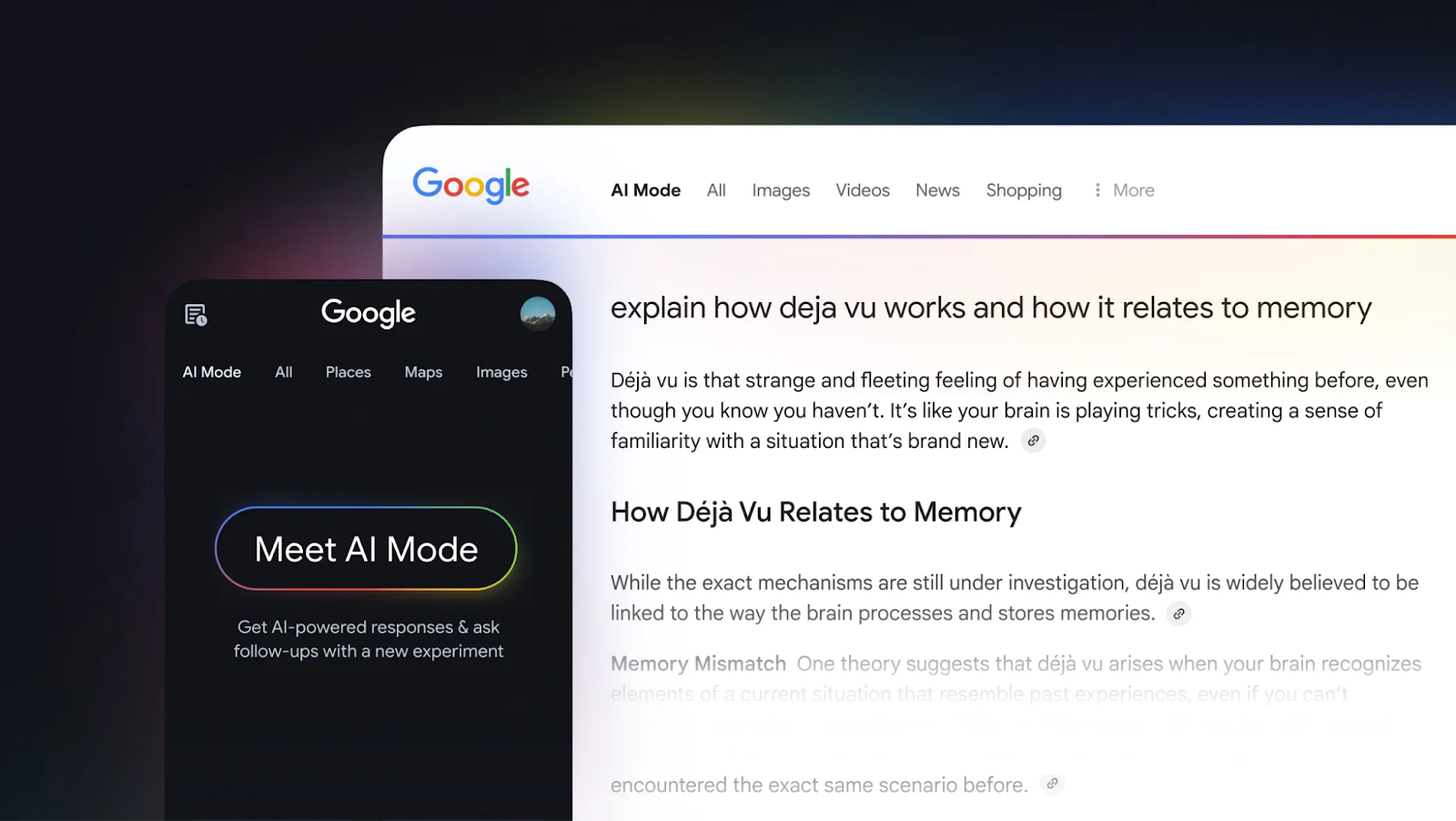
That’s a recipe for SERP volatility.
According to a Pew Research Center analysis in March 2025, pages featuring AI Overviews saw traditional click-through rates plunge from 15% down to just 8%, with a mere 1% of users clicking the source link inside the summary.
One week you’re pulling in steady traffic, the next you’re invisible for the same query. Publishers in content-heavy niches are already feeling the sting, with some reporting massive drops in organic search visits since AI testing began.
The New York Times saw its organic search share fall from 44% to 36.5% between 2022 and 2025, while Business Insider traffic dropped around 55% and HuffPost also lost over half its search referrals.
It’s not just about losing position.
It’s about losing screen time. If AI Mode can answer the question, users may never reach your beautifully crafted page.
And because AI-generated answers can change from one session to the next, your rankings can look fine in the morning and be gone entirely by lunch.
Bottom line: AI search is rewriting the rules. If you’re not thinking about how to make your content visible in AI Overviews, you’re playing a game where the board keeps moving.
3. New content
Sometimes the reason your rankings drop is simple: someone else just showed up with something better.
When competitors publish fresh, high-quality pages—or update existing ones—they can steal your spot in the search engine rankings. Google loves quality content that’s current, relevant, and matches user intent, so a newly published guide or a refreshed blog post can push your page down.
This is especially common in fast-moving industries where facts, stats, and best practices change quickly.
If your content is outdated while your competitor’s is new, guess which one the algorithm is more likely to put on top?
When you notice a ranking drop, review the SERP for your target keywords.
If there’s new or updated content above you, that’s a clear sign you need to refresh your own page. Whether that’s adding recent data, improving content quality, or expanding coverage of the topic.
Surfer's Content Audit tool automatically tracks informational updates in your content, so you know when and what to add to your pages.
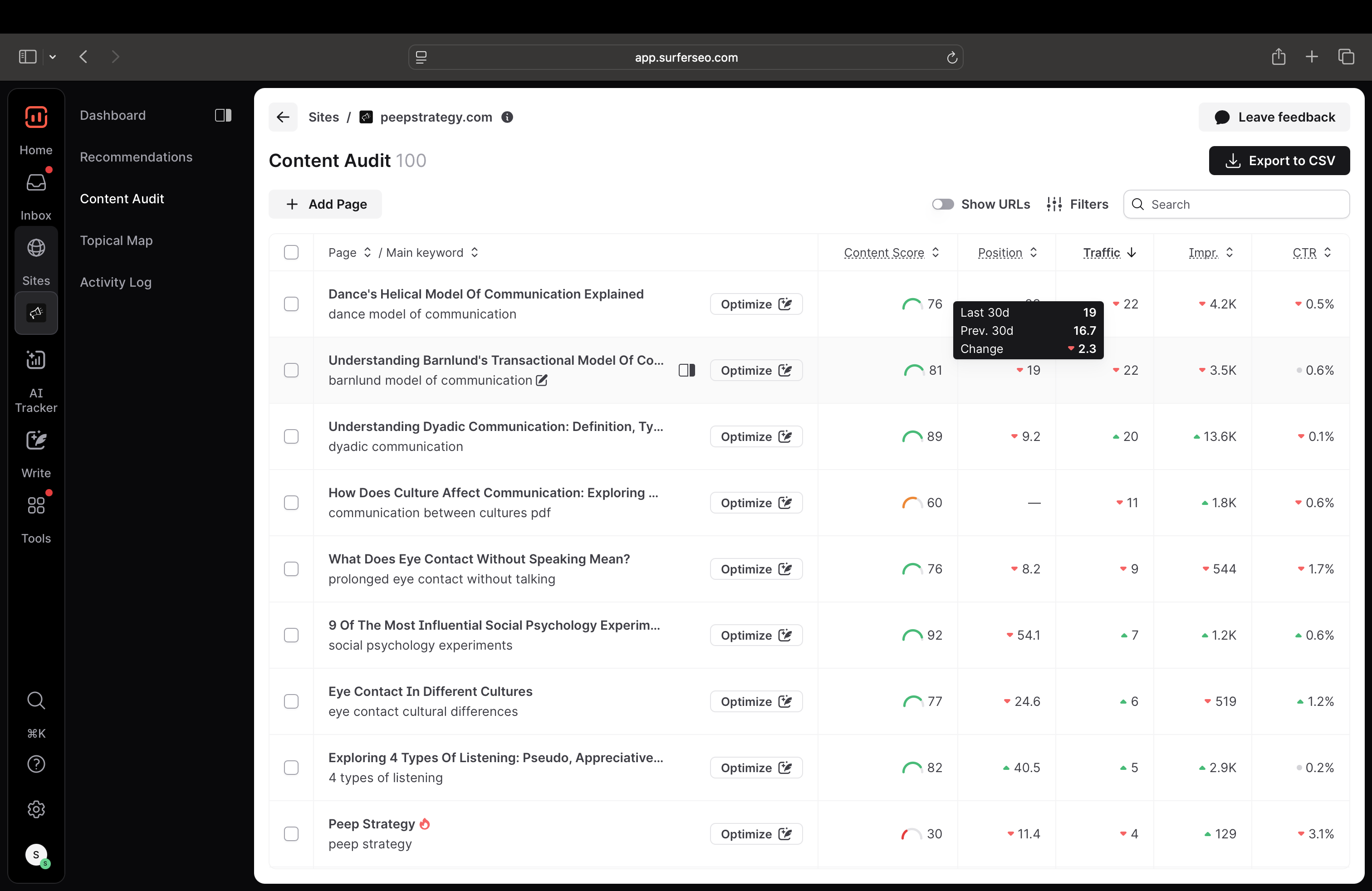
Freshness matters. In the world of Google rankings, it’s survival of the most relevant.
4. Changes in authority
Google doesn’t just look at what your page says. It also looks at who is saying it. That’s where authority comes in.
Authority is built through signals like high quality backlinks, brand mentions, and overall trust in your site.
When your authority grows, your search rankings often follow. But when authority drops, so can your keyword positions.
A shift can happen for a few reasons:
- You gain powerful links from reputable sites.
- You lose important links because a page was deleted, restructured, or no longer points to you (lost backlinks).
- Competitors earn better links, making their content look more trustworthy than yours.
Even small changes in your backlink profile can trigger ranking fluctuations, especially in competitive niches.
Google’s algorithm is always comparing sites against each other. If your site’s authority weakens while a competitor’s strengthens, expect to see movement in the SERP.
When you notice volatility, check your link data.
You can use link tools to help you spot toxic links, find broken links to reclaim, and identify opportunities to build new authority.
Authority takes time to earn but can be lost quickly. Keep it growing, and your rankings are more likely to hold steady.
5. Shifts in user behavior
Sometimes your rankings change because your audience changes.
When people search differently, Google adapts the search results to match what they want in that moment. This could be seasonal—like “best running shoes” spiking in January when everyone is on a fitness kick—or trend-driven, when a new product or idea takes over your niche.
It can also be a shift in user intent. Maybe your article ranks for “podcast equipment” and used to attract readers looking for detailed buying guides.
But now, most search queries for that term lead to quick comparison charts or “best of” lists. If your page doesn’t match the new preferred format, your keyword positions can slide.
We’ve even seen this happen on Surfer’s own content.
One article lost rankings because intent shifted from “how-to” guides to “free tools.” Our solution? Launching a free tool to meet that demand.
The takeaway: watch the SERPs, not just your own rankings. If the type of content Google is showing changes, it’s a sign you need to adapt.

6. Personalization and localization
Not every user sees the same Google results.
Google tailors search results based on location, search history, and browsing patterns. That means your page could rank number one for you in New York, but only show up in position eight for someone in Los Angeles.
Localization plays a big role for businesses with a physical presence or regional focus.
A restaurant’s Google Business Profile will naturally rank higher in its own city than somewhere across the country. Even national brands can see fluctuations if Google detects the search has local intent—think “best coffee shop” or “SEO agency near me.”
Personalization is also at work.
If a user often clicks results from a particular site, Google might prioritize that site in future searches for them. That’s great for loyal audiences, but it can make rankings look volatile when you compare different devices, accounts, or locations.
When tracking your keyword rankings, use a rank tracking tool that lets you set a fixed location. This gives you a consistent view of your true performance, without the noise from personalization.
7. Indexing and site issues
Sometimes, volatility has nothing to do with your content or competitors. It’s your site sending the wrong signals to search engine crawlers.
If Google can’t properly crawl, index, or load your pages, they can temporarily vanish from organic search results.
Common culprits include:
- Broken links or deleted pages without redirects
- Accidental noindex tags
- Server downtime or multiple servers causing inconsistencies
- Slow load times or poor mobile usability
- Core Web Vitals issues affecting performance
Even small technical issues can cause a ranking drop, especially if they affect key traffic-driving pages. For example, if your homepage is down for a few hours, it can impact your entire site’s perceived reliability.
To spot these problems, regularly check your indexing status in Google Search Console and run site audits with SEO tools.
Fixing technical issues quickly can help restore lost positions and keep rankings stable.
How to monitor SERP volatility in 4 ways
Knowing why rankings change is one thing. Spotting those changes early is how you stay ahead of bigger problems.
Monitoring volatility helps you separate normal fluctuations from the kind that signal a deeper issue.
1. Use Google Search Console insights
Google Search Console is your free window into how your site performs in Google Search. The Performance report shows metrics like impressions, clicks, and average position over time.
By reviewing this data, you can spot unusual swings in your search rankings.
The 24-hour data view is especially helpful for catching short-term volatility. If positions jump significantly for multiple search queries in a single day, something’s up.
Always compare this with past weeks to confirm whether it’s just noise or a pattern.

Use volatility indexing tools
Volatility indexes track how turbulent the SERP is across the web.
They measure how much rankings are changing industry-wide and can help you figure out if the movement you see is unique to your site or part of a broader trend.
Tools worth checking:
Compare these with your Google Search Console data to see if your volatility matches bigger patterns.
2. Use a SERP rank tracking tool like Surfer
If you're serious about monitoring SERP volatility, a rank tracking tool is a must.
Google Search Console gives you historical performance, but it doesn’t let you zoom in on individual keyword rankings with the precision that a dedicated tool offers.
That’s where Surfer’s Rank Tracker comes in.
It tracks your target keywords daily and shows exactly how your positions are moving over time.
Making it much easier to spot patterns, detect volatility, and respond before it affects your organic traffic.
Enter the specific keywords you want to monitor (especially high-priority phrases that drive traffic or conversions).
Choose the country or region that matters most for your business. This eliminates the noise caused by localization and gives you a clear view of performance in your primary market.
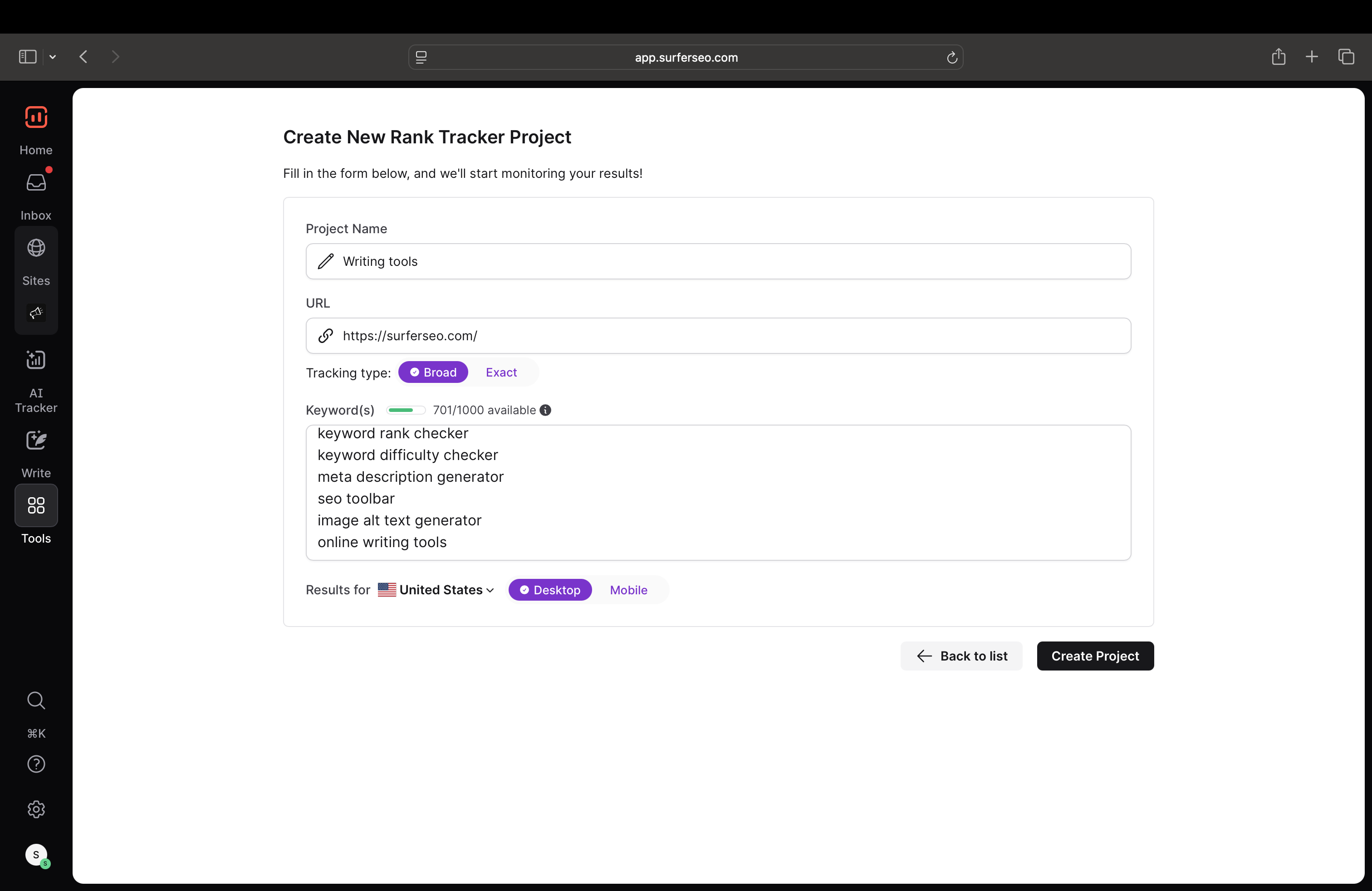
Surfer gives you a timeline view of each keyword’s position in the Google SERP over days, weeks, or months.
Look for big jumps, gradual climbs, or sudden dips that might signal algorithm shifts, content changes, or new competitors entering the field.
Whether you’re tracking a single page or your entire site, Surfer’s Rank Tracker gives you the visibility and control you need to understand when, why, and how your rankings fluctuate.
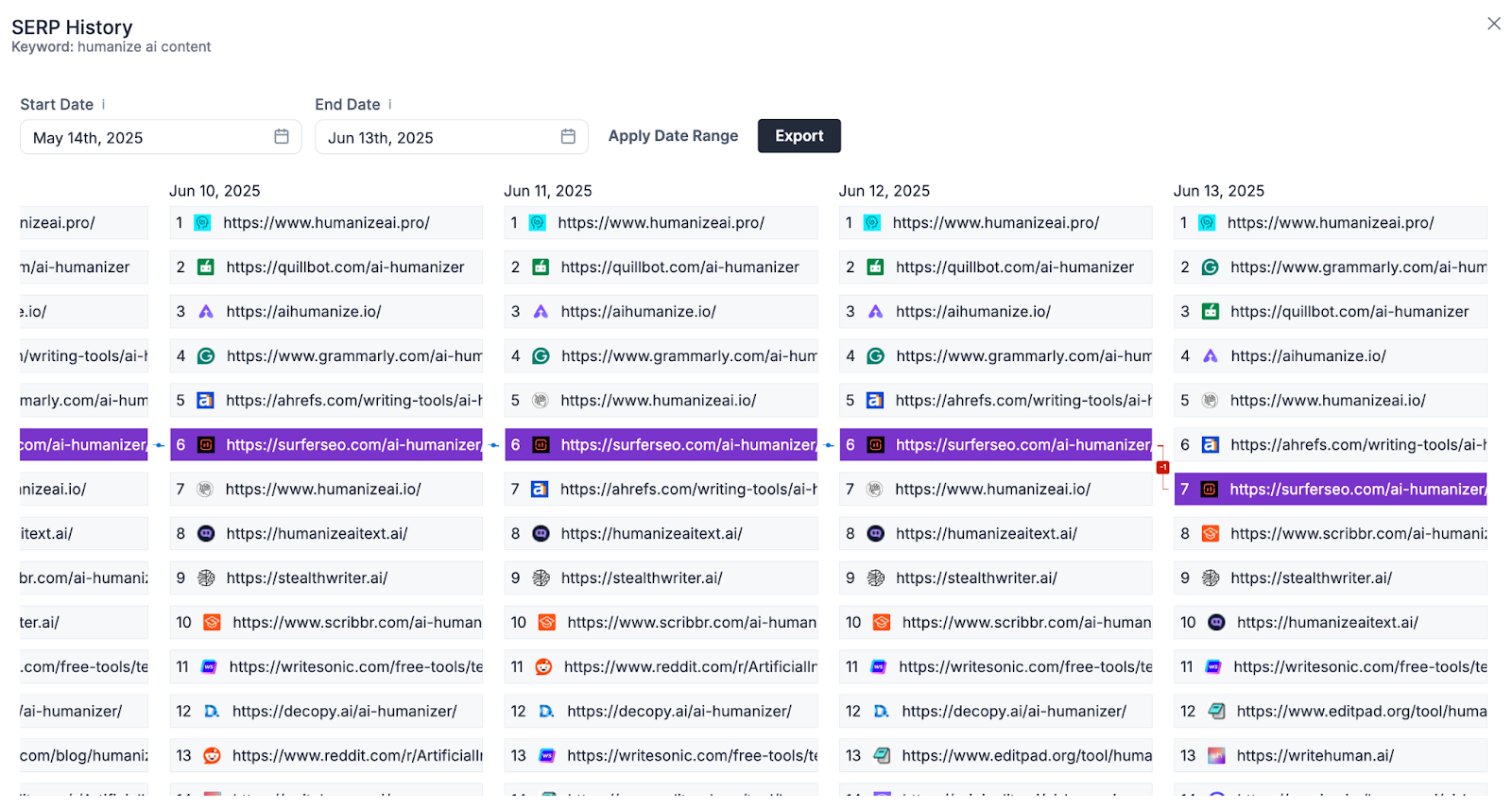
3. Check news and socials
When your rankings shift and no clear cause jumps out, it’s time to play SEO detective. One of the fastest ways to get answers?
Check industry news and social platforms.
Start with trusted SEO news sites. Search Engine Roundtable is the go-to hub for tracking confirmed and suspected Google updates.
Barry Schwartz monitors real-time chatter, tests, and announcements, often spotting ranking shifts before Google says a word.
Other reliable news sources include Search Engine Journal and Search Engine Land, which publish regular updates and expert breakdowns.
But don’t stop at blog posts.
Social platforms like LinkedIn, Reddit, and X (formerly Twitter) are goldmines for on-the-ground intel. If you see multiple SEO professionals talking about the same pattern, like traffic drops, AI Overview sightings, or changes in SERP features, you’re probably not alone.
Here’s how to monitor them effectively:
- Search hashtags like #GoogleUpdate, #SEOTwitter, and #SERPvolatility
- Follow credible voices like @glenngabe, @lilyraynyc, and @barryschwartz
- Join SEO communities like r/TechSEO, r/BigSEO, or Women in Tech SEO Slack
- Set Google Alerts for “Google algorithm update” or “ranking drops” to catch early news
Cross-reference what you find with your Google Search Console or Surfer Rank Tracker data. If others are reporting volatility on the same day your rankings changed, it likely confirms a broader trend.
And if you’re still not sure?
Ask.
SEO Twitter and LinkedIn love a good mystery. Just post what you’re seeing and ask if others are noticing the same thing. You’ll have 10 responses and three theories within the hour.
5 steps to handle SERP volatility
It’s one thing to notice your keyword rankings have dropped. It’s another to figure out what to do about it.
Not every dip is a disaster. Some volatility is totally normal. Other times, it’s a sign something deeper needs fixing.
Whether it’s your content, your site’s technical health, or Google just shaking things up again.
Here’s how to respond calmly and strategically when your rankings take a hit.
Step 1. Assess the situation
Step one: breathe. Not every ranking drop is cause for a full-blown SEO crisis response.
Fluctuations are part of the game, especially around algorithm updates. Google’s constantly testing, reshuffling, and evaluating content.
Here's an example of a normal page's keyword positions.
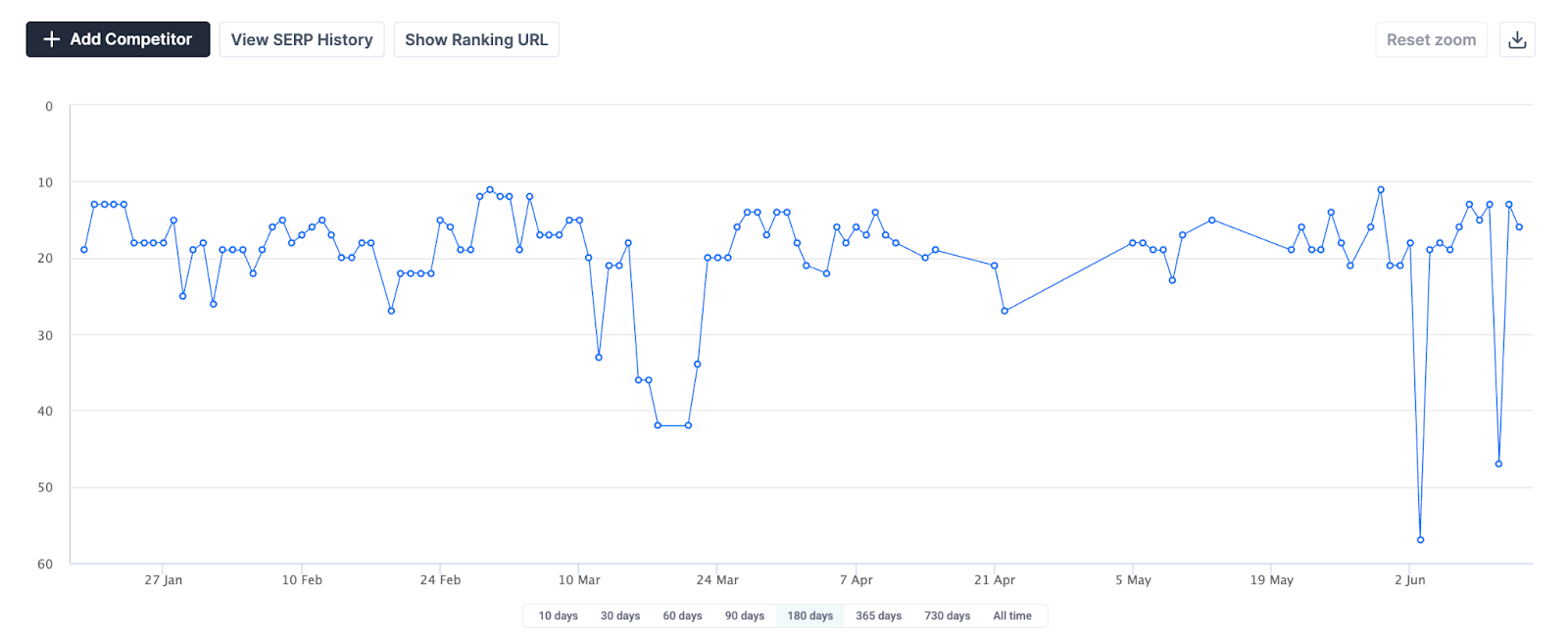
If your rankings dip today, they might bounce back tomorrow.
That’s why the first rule of handling SERP volatility is simple:
Don’t overreact too soon. Instead, give it time.
If your drop coincides with a confirmed or suspected Google update, wait at least 1–2 weeks before making any changes. Let the algorithm finish rolling out.
During that time, monitor your keyword rankings with a tool like Surfer’s Rank Tracker and watch for stabilization.
Before you even think about rewriting or overhauling content, ask yourself:
- Is this page still a genuinely helpful and accurate resource for the query?
- Does it match user intent and offer something unique?
- Is it well-structured, up-to-date, and easy to navigate?
If the answer is yes, resist the urge to tweak just for the sake of it.
Google often runs live tests to assess different content options in the search results. Making hasty changes mid-test can backfire or muddy your performance data.
Instead, use this time to consult Google’s content guidelines, especially the section on core update recommendations. They’re a goldmine for understanding what Google’s looking for and whether your page meets those expectations.
If your content holds up under that lens, the best move might be no move at all.
Step 2. Adapt to algorithm changes
If your rankings dropped and they haven’t recovered after a week or two, it’s time to dig deeper.
In order to adapt to algorithm updates, you need to start by figuring out what kind of Google algorithm update just happened. Was it a core update focused on broad content quality signals? Or a spam update targeting manipulative tactics like unnatural backlinks or keyword stuffing?
Google usually provides a short explanation of what each update was designed to target—check the Search Central blog or the Search Status Dashboard for details.
Understanding the why behind the update is your first step to recovering from it.
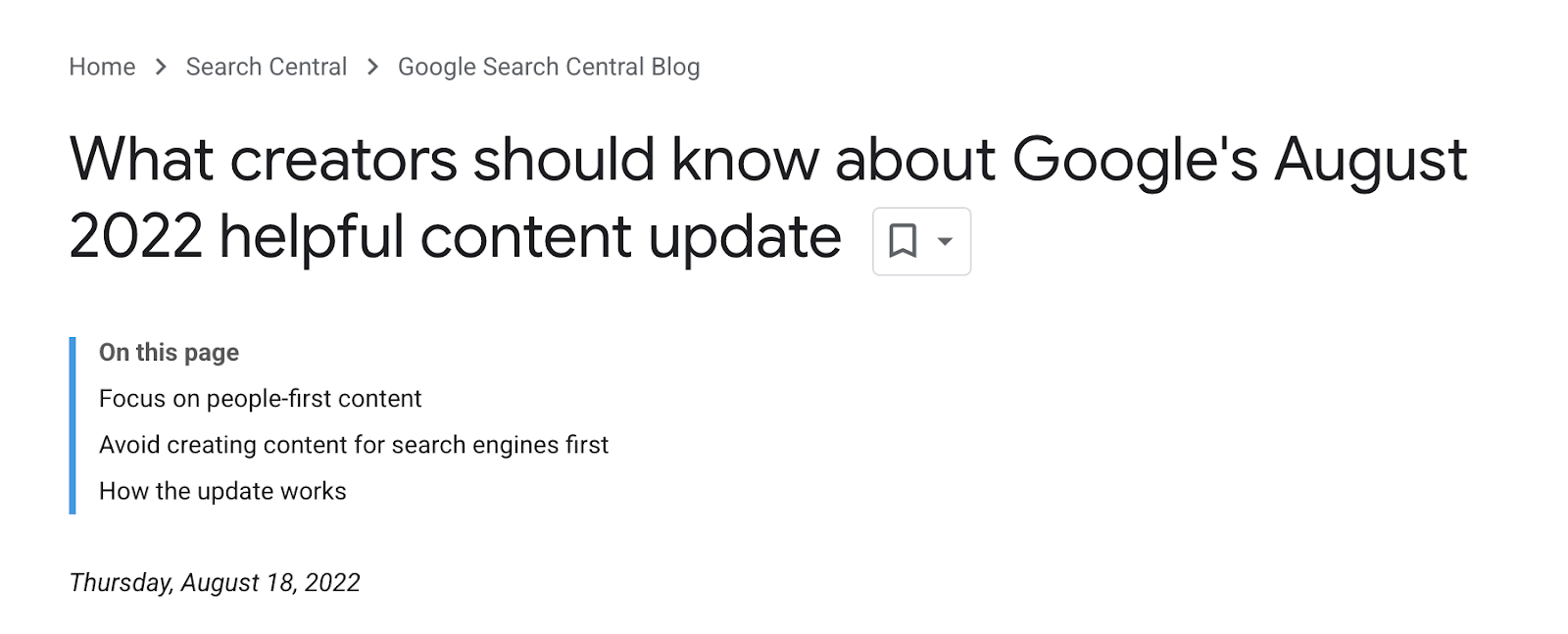
If the update focused on content quality (which many core updates do), the best move is a structured content audit.
Don’t just tweak your H1 and hope for the best. Instead, review:
- Is the page up to date?
- Does it reflect the latest best practices, trends, or data?
- Does it demonstrate authority and trustworthiness?
- Is it still the best answer to the query?
Even great content can fall behind. Maybe your article was written two years ago, and competitor pages are now fresher, more comprehensive, or more engaging.
If so, update it. Focus on improving content quality, adding clarity, and aligning with current user intent.
If the update was spam-related and your backlink profile or on-page SEO looks suspicious, you may need to clean up over-optimized pages or disavow toxic links. Not fun, but necessary.
The goal here isn’t to chase the algorithm, it’s to build pages that will survive the next update, not just recover from this one.
Step 3. Strengthen brand authority
If content is the muscle of your SEO strategy, brand is the skeleton holding it all together.
In the last few Google updates, it became painfully clear that content alone doesn’t cut it. Even great pages got buried while more established, recognizable brands soared. Why?
Because Google is placing bigger bets on trust, consistency, and authority, and that doesn’t come from publishing “10 Tips for X” blog posts on repeat.
It comes from being a brand people know, search for, and return to.
Let’s talk about what that looks like in the real world.
Diversify your traffic sources
If Google traffic is your only traffic, you're building your business on rented land. One update and poof…gone.
Real brands don’t just rely on one channel. They show up in inboxes, get shared in Slack groups, and pop up in TikTok DMs. They build ecosystems that drive traffic from multiple directions, not just from one blog post that happened to rank in 2023.
This isn’t about abandoning search. It’s about insulating your business from the chaos of it. The more ways people can find you, the less panic you’ll feel when the algorithm decides to change the rules again.
Create content that doesn’t need rankings to get seen
When you're a small brand, it's tempting to treat every piece of content like it's just there to rank. But that’s thinking small.
Think bigger. Think shareable. Think bookmark-worthy.
Think "someone finds this in a group chat and immediately sends it to their boss."
That might mean a free tool that solves a real problem.
Or a case study that proves you actually know what you’re doing. Or a mini tutorial that makes someone save your post and follow you instantly.
Ranking content is important, but the stuff people want to engage with, no matter where they find it?
That’s the stuff Google trusts more over time anyway.
Build links the way real businesses do
Forget cold outreach with fake compliments. The strongest backlink profiles I’ve ever seen came from brands that actually had something worth linking to. Tools. Data. Industry-shifting ideas.
You don’t need 500 random blog links. You need a handful of solid mentions from sites people trust, ideally because your content earned it.
That means getting quoted in the media. Showing up in newsletters. Partnering on webinars or workshops. Or better yet, building something cool enough that people can’t not mention it.
If your name starts showing up in the same places Google already trusts? That’s when authority starts to stick.
Be the same brand everywhere, every time
You can’t expect Google to trust your brand if it doesn’t know who you are. If your blog sounds like a corporate intern, your LinkedIn is fire, and your product pages read like legal disclaimers, Google—and users—get confused.
Strong brands have a vibe. A voice. A through-line.
Whether someone finds you on TikTok or stumbles on a blog post from two years ago, it should feel like you. That consistency isn’t just for the humans.
It helps algorithms categorize you correctly and makes your brand easier to connect across search features, entities, and future AI-powered experiences.
Think beyond Google’s front page
Ranking on Google is great. But you know what’s even better?
Being the brand that shows up everywhere people are searching.
Whether someone’s asking ChatGPT for a tool recommendation, scrolling TikTok for how-tos, or digging through Reddit for honest advice.
If your brand isn’t in that mix, you’re invisible.
And here’s the thing:
Those platforms do influence Google.
Mentions on Reddit, visibility on YouTube, and high engagement on social platforms all feed into the broader ecosystem that defines authority.
So stop thinking like a site, and start thinking like a brand people recognize on any platform, any algorithm, any format.
This is the stuff that protects you when rankings get rocky. Build a brand that’s bigger than a keyword, and volatility starts to feel like a speed bump, not a dead end.
Step 4. Adjust for changes in user intent
If your content was ranking and suddenly isn’t, it might be because what people want has changed.
Google updates the SERP based on how users interact with results. If searchers now prefer product pages, videos, or tools—and your post is a long blog article—you’re no longer meeting intent.
When volatility hits, check the current SERP. What’s ranking now? If your format or angle no longer fits, it’s time to adapt.
That doesn’t always mean rewriting everything. You might just need to restructure the page, add new sections, or introduce a downloadable asset that meets the new expectation.
Intent shifts are one of the most common reasons for ranking drops and one of the easiest to fix once you spot them.
A great real-world example?
When the search intent around “avoid AI detection” changed, I noticed our educational article was slipping, even though it was ranking well before.
The SERP had shifted to favor actual AI humanizer tools.
So we built one, launched it, and instantly reclaimed visibility.
Your content doesn’t live in a vacuum.
The better it aligns with what users now expect to see, the more likely it is to recover and hold its spot.
Step 5. Address technical foundations
Sometimes rankings tank not because of content, but because your site is silently falling apart.
If you’ve ruled out updates and intent shifts, it’s time to check for technical issues that may be blocking Google from properly crawling or ranking your content.
Start with your indexing status in Google Search Console.
If key pages have dropped out of Google’s index—or show as “Discovered – currently not indexed”—you may have an issue with crawl budget, site structure, or an accidental noindex tag.
Next, check performance. Poor Core Web Vitals, slow load speeds, or mobile usability problems can cause a drop in trust and rankings. Tools like PageSpeed Insights or Surfer Audit will help you identify what’s slowing you down.
Finally, review your internal links. If a high-value page suddenly has fewer links pointing to it—or is buried deep in your structure—it may be losing authority.
Technical health isn’t glamorous, but it’s essential. You can’t rank what Google can’t reach.
Key takeaways
- SERP volatility refers to frequent changes in keyword rankings, which can happen daily or even hourly depending on algorithm tests, user behavior, and technical site factors.
- You can identify volatility by tracking keyword positions over time using tools like Surfer’s Rank Tracker, reviewing Google Search Console data, and monitoring SERP trends across the industry.
- The most common causes of ranking fluctuations include algorithm updates, AI-generated results, new or improved competitor content, changes in authority, shifts in user intent, personalized search, and technical issues.
- To handle volatility, start by assessing the situation—many drops are temporary or part of Google testing. If needed, adapt your content based on update criteria, refine technical foundations, or improve alignment with evolving search intent.
- Strengthening your brand authority and diversifying visibility across platforms can make your rankings more stable and resilient over time.






